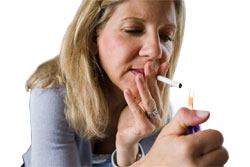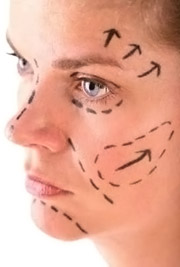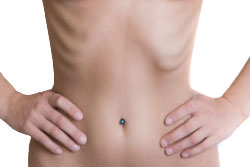- Types of cosmetic surgery
- Who should not undergo cosmetic surgery?
- Prevalence of cosmetic surgery
- Satisfaction with cosmetic surgery
- Medical ethics and the promotion of cosmetic surgery
What is cosmetic surgery?
Cosmetic surgery refers to a surgical procedure undertaken to reshape and change the appearance of a body part. It may change the structure, position, colour or texture of a body part or feature and is initiated by an individual who is unsatisfied with their appearance, rather than by a doctor who thinks the surgery will improve the individual’s health. There are also many other treatments undertaken for cosmetic purposes which do not involve surgery, but change the structure of body tissues. These are known as non-surgical cosmetic treatments.
Unlike the other major type of plastic surgery (reconstructive surgery), cosmetic surgery is undertaken for aesthetic rather than health reasons. It involves operating on healthy body parts, to change their appearance with the aim of improving an individual’s self-esteem and satisfaction with their appearance. While some procedures may also increase bodily function or reduce ill effects such as pain, cosmetic surgery procedures have the primary aim of improving appearance.
Types of cosmetic surgery
Body parts or systems operated
Surgeons can change the appearance of numerous body parts through cosmetic surgery. Some of the most common body parts which patients modify through cosmetic surgery, either changing the size or shape of, are:
Cosmetic surgery techniques and procedures
There are numerous operative techniques used in cosmetic surgery including:
- Lipoplasty (liposuction): This involves the removal of fat from the body through small cuts in the skin using suction techniques;
- Augmentation: This involves the implantation of devices to increase the size of a body feature (e.g. the breasts);
- Body contouring including lifts and tucks: These are procedures in which loose skin is removed and remaining skin tightened to give a more toned appearance;
- Reshaping procedures: The contour or shape of a feature is changed. These procedures might involve implants or removal or reshaping of bone or cartilage;
- Dermabrasion: This involves the scraping away of layers of skin; and
- Hair replacement: Skin with good hair growth is grafted onto bald areas where hair growth is desired.
 |
For more information, see Plastic Surgery Procedures |
Non-surgical cosmetic treatments
Non-surgical cosmfetic treatments are those which alter the appearance by changing the structure of body tissues, without surgery. Such procedures may be offered in non-medical settings including dental surgeries and beauty salons. While these treatments do not involve invasive surgery, they nonetheless carry risks and individuals should fully consider the risks and benefits of these treatments before consenting to undergo them.
Non-surgical cosmetic treatments include:
- Botulinum toxin injections (Botox): Typically into facial muscles to reduce the appearance of wrinkles;
- Dermal fillers: Dermal fillers include collagen derived from human and cow skin. In Australia collagen dermal fillers include the brands Cosmoderm, Cosmoplast, Zyderm and Zyplast. These are injected into the skin and reduce the appearance of wrinkles for 2–4 months;
- Chemical peels: In which chemical solutions containing phenol, trichloroacetic and alphahydroxy acids are applied to the skin in order the remove the outer layers of the dermis.
Who should not undergo cosmetic surgery?
There are numerous reasons why individuals cannot undergo cosmetic surgery (known as contraindications). Individuals taking medication or experiencing conditions which may impair the healing process cannot be operated on. People who are intending to undergo plastic surgery should also quit smoking before the procedure. Other contraindications vary depending on the procedure and the age of the person.
Teenager
All individuals under 18 years of age require parental consent to undergo plastic surgery. While there are no other medical contraindications to cosmetic surgery for teenagers, some professional associations (e.g. American Society of Plastic Surgeons) recommend that individuals under 18 years of age wait to have cosmetic surgery, so that they can further develop physically and emotionally.
Teenage girls who are considering undergoing breast augmentation should wait and see how their breasts develop. Those seeking liposuction should try to exercise and maintain a healthy diet, a strategy which will produce the weight reducing and appearance changing effects of liposuction, and also provide systemic health benefits.
Breast augmentation
Breast augmentation surgery (breast implants) should not be performed in women with:
- A history of unsuccessful breast augmentation surgery;
- A history of breast cancer;
- A history of malignant cancer at any site;
- A current or recent infection;
- Painful breast cysts (small sacks filled with gas, liquid or solid matter);
- Silicon allergy (for silicon filled implants);
- Use of medications which affects blood clotting; or
- Psychological or psychiatric illness (including body dysmorphic disorder, a condition in which the individual is preoccupied with small imperfections that other people do not notice).
Body contouring, lifts and tucks
Cosmetic procedures to tighten sagging skin cause the remaining skin to become thin and weak. Individuals who gain weight rapidly following skin removal procedures affecting areas which grow during weight gain (e.g. the buttocks and thighs but not the eyelids) may stress their skin and cause it to break. Only individuals who have stabilised their weight and committed to living a healthy lifestyle are able to undergo these procedures. Blepharoplasty (eyelid surgery) may be unsuitable for people with eye conditions including glaucoma, dry eye and detached retina.
Lipoplasty
Lipoplasty (liposuction) is recommended for individuals who are within 30% of their ideal body weight, with good skin tone and who maintain a healthy, balanced diet. It is not recommended as a treatment for obesity.
Prevalence of cosmetic surgery?
Hundred of thousands of cosmetic surgery procedures are carried out in the United States alone each year. For example, in 1999:
- Over 100,000 rhinoplasty (nose surgery) procedures were performed;
- 191,583 women underwent breast augmentation; and
- Almost 90,000 women had breast reduction surgery.
The number of cosmetic surgery procedures performed in the United States increased by 119% in the 1997–1999 period.
Women of all ages and backgrounds undergo cosmetic surgery. A woman typically requesting a breast implant is Caucasian, in her late twenties or early thirties (in contrast to the dominant stereotype of women in their late teens and early twenties getting breast implants). Women undergoing breast augmentation surgery vary in age from their late teens to their 40s and come from diverse ethnic backgrounds. Studies of liposuction patients have reported ages ranging from 17–74 years.
Teenagers
There has also been a substantial increase in the number of cosmetic surgery procedures performed on adolescent women. In the United States, 333,000 cosmetic procedures were performed on patients below the age of 18 years in 2005 compared to 14,000 in 1996. The most popular procedures performed on teenagers were lipoplasty and breast augmentation and an estimated 90% of the recipients were female.
A survey of Australian teenagers 11–18 years of age, conducted by a beauty magazine, reported that a quarter (1,000 out of the 4,000 who participated in the survey) would like to have cosmetic surgery. Eighty (2%) of the four thousand women surveyed had already undergone plastic surgery. Surgeons report that the procedures most commonly requested by teenagers are breast augmentation, lipoplasty and rhinoplasty.
Australian women
Since data on cosmetic surgery procedures is not routinely collected in Australia, the number and types of procedures performed in Australia is unknown, as are the characteristics of Australian women who undergo plastic surgery.
The Women’s Health Study, a nationally representative study of women’s health in Australia is the first study to provide reliable data on the prevalence of cosmetic surgery in the country. In this study 7% of women aged 45–50 reported having had plastic surgery, although the survey did not distinguish between types of surgery, including whether the surgery was cosmetic or reconstructive. Amongst women in this age group, the likelihood of having had cosmetic surgery was increased amongst women:
- Working in professional, sales, managerial and administrative jobs, compared to those working in trades, mechanical and other occupations. These women were approximately 50% more likely to have undergone cosmetic surgery;
- With chronic illnesses;
- Who use medication;
- Who experience anxiety;
- Who experience sleep disturbance;
- Who have undergone non-cosmetic surgical procedures. Those who had undergone two non-cosmetic operations were approximately 1.5 times more likely to have had cosmetic surgery than those who had not had non-cosmetic surgery, while those who had five or more non-cosmetic procedures were 3.2 times more likely to have had cosmetic surgery;
- Who consult more frequently with medical specialists or alternative medicine practitioners. This is true even after taking into consideration that women with chronic illnesses are more likely to seek medical consultation.
Other factors which increase the likelihood a woman will undergo cosmetic surgery include:
- Education;
- Culture;
- Body image;
- Teasing history; and
- self-esteem.
Satisfaction with cosmetic surgery
Most patients undergo cosmetic surgery because they are unhappy with their body image and have associated issues with self-esteem and confidence which they wish to reduce. As such it is reasonable to measure the success of cosmetic surgery procedures not only in terms of satisfaction with appearance after surgery, but also in terms of resulting psychological changes such as improved self-esteem.
Psychological outcomes following cosmetic surgery are hard to determine, but a number of factors have been associated with an increased risk of poor psychological outcomes following cosmetic surgery. These include:
- Being male;
- Being young;
- Existing psychological conditions including depression, anxiety and personality disorders;
- Undergoing an extensive type change procedure such as nose surgery or breast augmentation (implants) was more likely to cause severe body image problems compared to undergoing a procedure which restores a previous image such as a face lift;
- Experiencing sensory disturbance such as loss of nipple sensation or skin tightening may also increase the risk of body-image disturbance;
- Having unrealistic expectations of the surgery, i.e. that the surgery will change factors other than appearance (e.g. social networks, relationship, employment opportunities) increases the risk of poor psychological outcomes following surgery;
- Experiencing body dysmorphic disorder, a condition in which the individual is obsessed with minor irregularities which are unnoticed by others. These individuals account for some 6–15% of all people consulted in the plastic surgery setting and most of them report being unsatisfied with the outcomes of their surgery.
Medical ethics and the promotion of cosmetic surgery
The promotion of plastic surgery in Australia has raised considerable concern regarding ethical medical practice. While Australian laws prohibit the promotion of deceptive and misleading information, they also distinguish between misleading information and “puffery or self-evident exaggeration”. In this regard the promotion of cosmetic surgery has been criticised for playing on an individual’s insecurities about their appearance, and particularly insecurities about having a normal appearance for a person of their age and equating a normal ageing appearance with an undesirable appearance. In societies where many individuals express dissatisfaction with their physical appearance, such promotion is potentially unethical. However, recent legislative changes in Australia, which put restrictions on the use of before and after photographs and the use of confusing statistical information, are expected to provide better protection for individuals contemplating plastic surgery.
Cosmetic surgery advertising promotes the procedures for vanity, rather than for improving health. While these tactics are common features of beauty industry advertising, they raise particular concern in the medical profession, which is bound by ethical and professional considerations to diagnose and treat disease in order to protect patients’ health. Because cosmetic surgery carries health risks but is not indicated for health reasons, the following concerns have been highlighted in relation to its advertising in the Australian context:
- That cosmetic surgery media is often written by the medical practitioners who profit from performing cosmetic operations, and media copy is often accompanied by advertisements for the same practitioner’s service;
- Cosmetic surgery promotion often describes a normal, ageing appearance as undesirable and uses emotive language to describe such appearances;
- Using models who have not undergone plastic surgery in advertisements implying that the model’s look was achieved through plastic surgery;
- Using misleading before and after photos, for example photos which have been enhanced, before and after shots which differ in terms of resolution, size, colour or pose.
Concerns have also been raised regarding the influence of reality television programs in which contestants compete to change their image by undergoing drastic cosmetic surgery procedures. An American study reported that 80% of cosmetic surgery patients interviewed had been influenced to some degree by television programs. These shows have been criticised for downplaying the risks involved, misrepresenting the length of time in which recovery and dramatic feature changes are achieved and exaggerating the likelihood of a positive outcome. However, individuals who watch cosmetic television shows regularly are more likely to believe that reality programs are similar to real life. Cosmetic surgery ‘reality’ television programs are also thought to be a factor driving the increasing incidence of cosmetic surgery in Western countries. Concern for the health and ethical rights of participants has also been raised, as the extremely rapid appearance changes which they undergo may create physical and psychological health risks.
References
- Ring A. Using “anti-ageing” to market cosmetic surgery: just good business or another wrinkle on the face of medical practice. Med J Aust. 2002;176(12):597-9. [Abstract | Full text]
- Cosmetic surgery: Information for patients [online]. London: Department of Health; 2010 [cited 2 May 2010]. Available from: URL link
- What is the difference between cosmetic and reconstructive surgery? [online]. Arlington Heights, IL: American Society of Plastic Surgeons; 2010. [cited 5 May 2010]. URL link
- Plastic and Cosmetic Surgery [online]. Bethesda. MD: National Library of Medicine; 2010. [cited 5 May 2010]. Available from: URL link
- Procedures Overview [online]. St Leonards, NSW: Australian Society of Plastic Surgeons; 2009. [cited 2 May 2010] Available from: URL link
- Injectable fillers [online]. St Leonards, NSW: Australian Society of Plastic Surgeons; 2009. [cited 10 May 2010]. Available from: URL link
- Chemical Peel [online]. St Leonards, NSW: Australian Society of Plastic Surgeons; 2009. [cited 10 May 2010]. Available from: URL link
- Arm Lift [online]. St Leonards, NSW: Australian Society of Plastic Surgeons; 2009. [cited 10 May 2010]. Available from: URL link
- Have your say: Children and young people using cosmetic surgery and solariums in Queensland [online]. Brisbane: Queensland Health; 2007. [cited 14 May 2010]. Available from: URL link
- Zuckerman D, Abraham A. Teenagers and cosmetic surgery: Focus on breast augmentation and liposuction. J Adoles Health. 2008;43(4):318-24. [Abstract]
- Breast Implants Information Booklet [online]. Woden, ACT: Therapeutic Goods Administration; 2001. [cited 10 May 2010]. Available from: URL link
- Crerand C, Infield A, Sarwar D. Psychological considerations in cosmetic breast surgery. Plast Surg Nurs. 2009;29(3):146-54. [Abstract]
- Body contouring [online]. St Leonards, NSW: Australian Society of Plastic Surgeons; 2009. [cited 10 May 2010]. Available from: URL link
- Eyelid surgery [online]. St Leonards, NSW: Australian Society of Plastic Surgeons; 2009. [cited 10 May 2010]. Available from: URL link
- Liposuction [online]. St Leonards, NSW: Australian Society of Plastic Surgeons; 2009. [cited 10 May 2010]. Available from: URL link
- Castle D, Honigman R, Phillips K. Does cosmetic surgery improve psychosocial well-being. Med J Aust. 176(12):601-4. [Abstract | Full text]
- Sarwar D. The psychological aspects of cosmetic breast augmentation. Plast Reconstr Surg. 2007;120(Supp 1):110-117S. [Abstract]
- Commons G, Halperin B, Chang C. Large volume liposuction: a review of 631 consecutive cases over 12 years. Plast Reconstr Surg. 2001;108(6):1753-63. [Abstract]
- Hussain R, Schofield M, Loxton D. Cosmetic surgery history and health service use later in life: Women’s health Australia. Med J Aust. 2002;176(12):576-9. [Abstract | Full text]
- Haas CF, Champion A, Secor D. Motivating factors for seeking cosmetic surgery: a synthesis of the literature. Plast Surg Nurs. 2008;28(4):177-82. [Abstract]
- Peters MJ, Morgan LC, Gluch L. Smoking cessation and elective surgery: the cleanest cut. Med J Aust. 2004;180(7):317-8. [Full text]
- Medical Practice Amendment (Advertising) Regulation 2008 [online]. Sydney: NSW Government; 2008. [cited 14 May 2010]. Available from: URL link
- Mudge T, Dashwood D. A change in the make up of medicine. Med J Aust. 2002;176(12):569-70. [Full text]
- Crockett R, Pruzinsky T, Persing J. The influence of plastic surgery “reality TV” on cosmetic surgery patient expectations and decision making. Plast Reconstr Surg. 2007;120(1):316-24. [Abstract]
- Petrie K, Faasse K, Fuhrmann S. Influence of television on demand for cosmetic surgery. Med J Aust. 2008;189(5):244-5. [Abstract | Full text]
All content and media on the HealthEngine Blog is created and published online for informational purposes only. It is not intended to be a substitute for professional medical advice and should not be relied on as health or personal advice. Always seek the guidance of your doctor or other qualified health professional with any questions you may have regarding your health or a medical condition. Never disregard the advice of a medical professional, or delay in seeking it because of something you have read on this Website. If you think you may have a medical emergency, call your doctor, go to the nearest hospital emergency department, or call the emergency services immediately.














